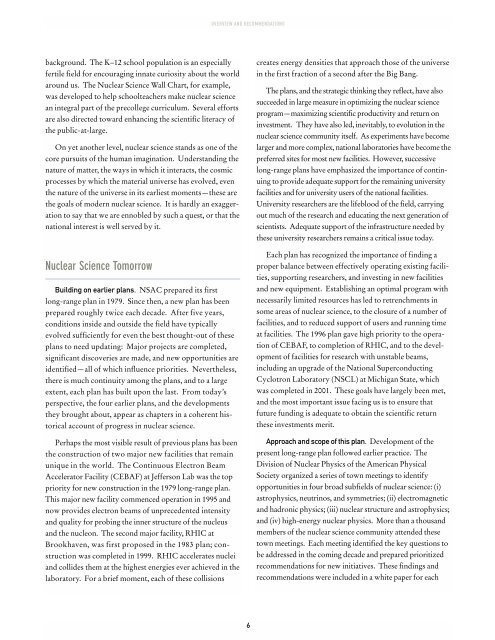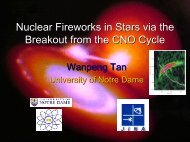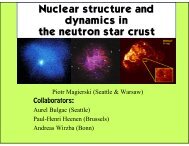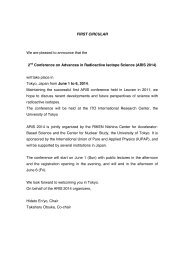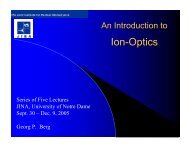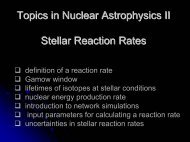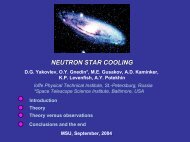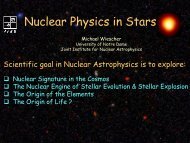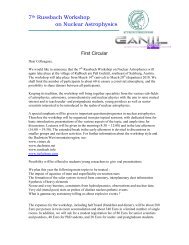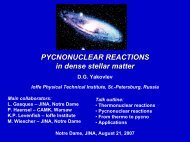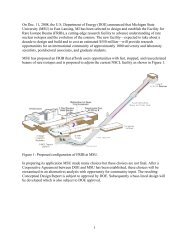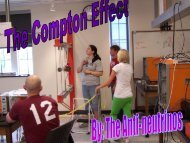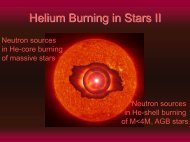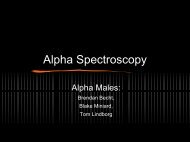OPPORTUNITIES IN NUCLEAR SCIENCE A Long-Range Plan for ...
OPPORTUNITIES IN NUCLEAR SCIENCE A Long-Range Plan for ...
OPPORTUNITIES IN NUCLEAR SCIENCE A Long-Range Plan for ...
You also want an ePaper? Increase the reach of your titles
YUMPU automatically turns print PDFs into web optimized ePapers that Google loves.
OVERVIEW AND RECOMMENDATIONS<br />
background. The K–12 school population is an especially<br />
fertile field <strong>for</strong> encouraging innate curiosity about the world<br />
around us. The Nuclear Science Wall Chart, <strong>for</strong> example,<br />
was developed to help schoolteachers make nuclear science<br />
an integral part of the precollege curriculum. Several ef<strong>for</strong>ts<br />
are also directed toward enhancing the scientific literacy of<br />
the public-at-large.<br />
On yet another level, nuclear science stands as one of the<br />
core pursuits of the human imagination. Understanding the<br />
nature of matter, the ways in which it interacts, the cosmic<br />
processes by which the material universe has evolved, even<br />
the nature of the universe in its earliest moments—these are<br />
the goals of modern nuclear science. It is hardly an exaggeration<br />
to say that we are ennobled by such a quest, or that the<br />
national interest is well served by it.<br />
Nuclear Science Tomorrow<br />
Building on earlier plans. NSAC prepared its first<br />
long-range plan in 1979. Since then, a new plan has been<br />
prepared roughly twice each decade. After five years,<br />
conditions inside and outside the field have typically<br />
evolved sufficiently <strong>for</strong> even the best thought-out of these<br />
plans to need updating: Major projects are completed,<br />
significant discoveries are made, and new opportunities are<br />
identified—all of which influence priorities. Nevertheless,<br />
there is much continuity among the plans, and to a large<br />
extent, each plan has built upon the last. From today’s<br />
perspective, the four earlier plans, and the developments<br />
they brought about, appear as chapters in a coherent historical<br />
account of progress in nuclear science.<br />
Perhaps the most visible result of previous plans has been<br />
the construction of two major new facilities that remain<br />
unique in the world. The Continuous Electron Beam<br />
Accelerator Facility (CEBAF) at Jefferson Lab was the top<br />
priority <strong>for</strong> new construction in the 1979 long-range plan.<br />
This major new facility commenced operation in 1995 and<br />
now provides electron beams of unprecedented intensity<br />
and quality <strong>for</strong> probing the inner structure of the nucleus<br />
and the nucleon. The second major facility, RHIC at<br />
Brookhaven, was first proposed in the 1983 plan; construction<br />
was completed in 1999. RHIC accelerates nuclei<br />
and collides them at the highest energies ever achieved in the<br />
laboratory. For a brief moment, each of these collisions<br />
creates energy densities that approach those of the universe<br />
in the first fraction of a second after the Big Bang.<br />
The plans, and the strategic thinking they reflect, have also<br />
succeeded in large measure in optimizing the nuclear science<br />
program—maximizing scientific productivity and return on<br />
investment. They have also led, inevitably, to evolution in the<br />
nuclear science community itself. As experiments have become<br />
larger and more complex, national laboratories have become the<br />
preferred sites <strong>for</strong> most new facilities. However, successive<br />
long-range plans have emphasized the importance of continuing<br />
to provide adequate support <strong>for</strong> the remaining university<br />
facilities and <strong>for</strong> university users of the national facilities.<br />
University researchers are the lifeblood of the field, carrying<br />
out much of the research and educating the next generation of<br />
scientists. Adequate support of the infrastructure needed by<br />
these university researchers remains a critical issue today.<br />
Each plan has recognized the importance of finding a<br />
proper balance between effectively operating existing facilities,<br />
supporting researchers, and investing in new facilities<br />
and new equipment. Establishing an optimal program with<br />
necessarily limited resources has led to retrenchments in<br />
some areas of nuclear science, to the closure of a number of<br />
facilities, and to reduced support of users and running time<br />
at facilities. The 1996 plan gave high priority to the operation<br />
of CEBAF, to completion of RHIC, and to the development<br />
of facilities <strong>for</strong> research with unstable beams,<br />
including an upgrade of the National Superconducting<br />
Cyclotron Laboratory (NSCL) at Michigan State, which<br />
was completed in 2001. These goals have largely been met,<br />
and the most important issue facing us is to ensure that<br />
future funding is adequate to obtain the scientific return<br />
these investments merit.<br />
Approach and scope of this plan. Development of the<br />
present long-range plan followed earlier practice. The<br />
Division of Nuclear Physics of the American Physical<br />
Society organized a series of town meetings to identify<br />
opportunities in four broad subfields of nuclear science: (i)<br />
astrophysics, neutrinos, and symmetries; (ii) electromagnetic<br />
and hadronic physics; (iii) nuclear structure and astrophysics;<br />
and (iv) high-energy nuclear physics. More than a thousand<br />
members of the nuclear science community attended these<br />
town meetings. Each meeting identified the key questions to<br />
be addressed in the coming decade and prepared prioritized<br />
recommendations <strong>for</strong> new initiatives. These findings and<br />
recommendations were included in a white paper <strong>for</strong> each<br />
6


